Unit of currentThe S.I unit of current is Ampere. S.I. or International System of Units is the system of standard units that are accepted worldwide. According to the S.I, the unit of current is Ampere. Current is also known as electric current due to the presence of electrons that possess electric charge. Electric current also creates magnetic fields used in generators, motors, and transformers to generate power. It is also transmitted through wires and cables at long distances. Alternating current is preferred for transmission at long distances due to low losses and cost compared to Direct Current. The current in semiconductors is due to the presence of electrons and holes. The electrons are the positively charged ions, and holes are the negatively charged ions. S.I unit of currentThe S.I unit of current is Ampere. 1 Ampere is defined as one coulomb of electric charge flowing across a circuit in one second. It is given by: 1 Ampere = 1 coulomb/ 1 second A = C/s The formula of electric current according to Ohm's law is given by: I = V/R Where, I is the current measured in Amperes V is the voltage measured in Volts R is the resistance measured in Ohms The unit of electric current (Ampere) is same in various field of electrical, electronics, and sciences. The unit of current can also be in the form of mA (Milli Amperes), uA (micro Amperes), etc. We have studied a lot about electric currents since our childhood. But, do we know the formation of electric current. If no, let's first discuss the formation of electric current. Formation of electric currentConsider the below circuit. 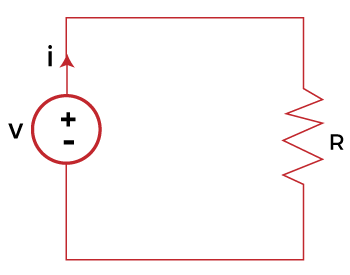
It consists of a resistor, and a battery connected with the help of wires. The battery is made of metal and has two electrodes and an electrolyte. The electrolyte is a chemical combination. The two electrodes are named the positive electrode (anode) and a negative electrode (cathode). The chemical structure of a battery creates chemical energy. It is further converted into electrical energy with the help of electrons. The chemical energy inside a battery pushes the electrons from the positive terminal to the negative terminal. The flow of electrons generates an electric current that can be used for various purposes. Here, the battery is connected to the resistor. So, the electric current from the battery will flow through the wire across the circuit. If any bulb is connected to the circuit, it will glow. Similarly, electric current is formed in other types of batteries and charged devices. Measurement of currentThe device used to measure the current is known as Ammeter. It displays the current in Amperes. It is known as a measuring instrument that measures the amount of current flowing in a circuit. For example, the current flowing in an open circuit is always zero. It is because the two ends of the circuit are not in contact. The open contact does not provide a path for the current flow, and the Ammeter shows zero reading. The direct current and alternating current is measured in Amperes by the Ammeter. It means that an ammeter can measure both the DC and AC current. Other S.I unitsApart from current, there are S.I units of various electrical parameters. It is shown in the below table.
Types of Current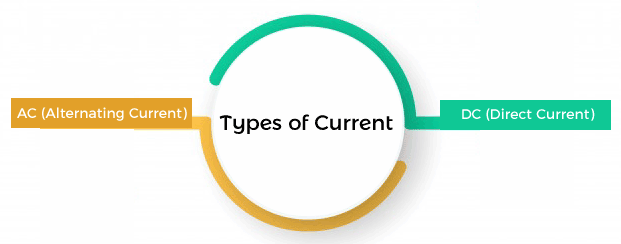
AC (Alternating Current)AC is the flow of current that continuously changes its magnitude and direction with time. It is the form of electrical energy that is consumed directly via power sockets to which various devices, such as electric lamps, televisions, and other electronic devices. The waveform of the A.C. signal is in the shape of sinusoidal, where the first half of the waveform represents the positive half cycle and the second half represents the negative half cycle. A single cycle comprises both positive and negative half-cycles. It is shown below: 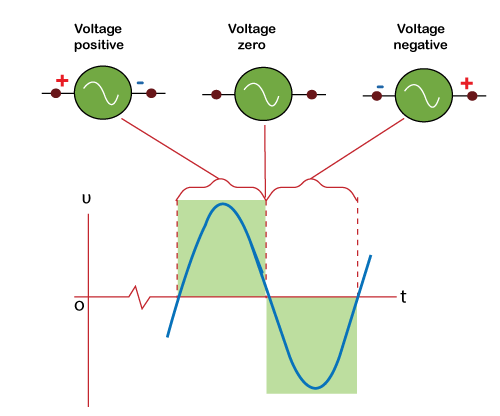
DC (Direct Current)Direct current is the flow of current in one direction. The flow of current in constant direction makes it different from the Alternating Current. DC can be converted into AC with the help of a rectifier and inverter. The uses of Direct Current include charging of cells, chargers, and motors. High-voltage DC can be used for electrochemical processes and transmitting a large amount of power from generation sides to power grids. Types of AmmeterWe have discussed that an ammeter is used to measure the current flowing in the circuit. Similarly, a Voltmeter is used to measure voltages. Some ammeters can only measure direct current, while some can measure both direct and alternating current. The types of ammeter are listed below: Based on construction
Let's discuss the types of ammeter. Permanent moving coil Ammeter It measures only Direct Current. As the name implies, it has a permanent magnet between which the conductor is placed. When the current passes through the circuit, the magnetic field is induced with the help of magnets. The ammeter shows deflection depending on the amount of current flowing. Moving iron Ammeter It can measure both A.C. and D.C. When the electromagnetic force is applied to the Ammeter circuit, the piece of iron inside it moves. It is used in industries to measure the current in industrial frequency A.C. circuits. Digital Ammeter Digital Ammeter also measures the current in Amperes, but the value appears on the digital display instead of the analog meter. Such ammeters are also connected in series with the circuit. The series connection easily allows the current to pass through the ammeter. Moving magnet Ammeter It is based on the magnetic defection with the help of two springs, which provides the restoring force to the needle. The electric current in the circuit causes the coil to move in the Electrodynamics Ammeter It uses an electromagnet instead of a permanent magnet. It can measure both Alternating and Direct Current. Rectifier Ammeter As discussed, rectifier is also used to convert the Direct current into alternating current. Thus, the rectifier ammeter can only measure alternating current. If uses the rectifying instrument (rectifier) along with the moving coil to measure current. Integrating Ammeter The integrating ammeters are generally used for estimating the charge of a capacitor or a battery. Based on the measurement of currentThe ammeters based on the measurement of current are categorized as AC ammeter and DC Ammeter. AC Ammeter measures the Alternating current. We can also say that the AC ammeter measures the RMS value of the AC current. The DC Ammeter measures the Direct Current. Numerical ExamplesLet's discuss two examples of electric current. Example 1: Find the current flowing across the three resistors of 5 Ohms each connected in series with a voltage of 60V. 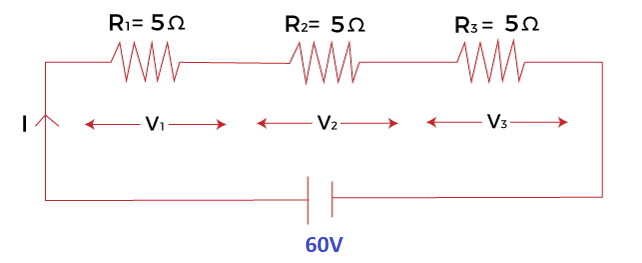
Solution: Since there is no parallel connection in the circuit, we will consider the circuit in series. If there was a parallel connection, the current would be divided among the branches according to the parameters on the specific branch. We know, I = V/R The resistance in series is always added. So, R = 5 + 5 + 5 = 15 Ohms V = 60V (Given) I = V/R I = 60/15 I = 4 Amperes Thus, the current flowing across each resistor is 4 Amperes. Note: The voltage across each resister is different when connected in series.Example 2: Find the current flowing across the three resistors of 2 Ohms, 4 Ohms, and 4 Ohms connected in parallel with a voltage of 12V. Also find the resultant resistance of the circuit. Solution: Here, the resistor in each branch is connected in parallel with the other branch. It means that the current flowing from the source will be divided among these three branches. Thus, each branch will have different current. V = 12 Volts (Given) We can name the current as I1, I2, and I3. The current will be divided, as shown below: 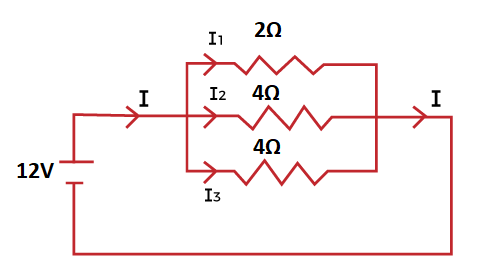
I1 = V/R1 = 12/2 = 6 A I2 = V/R2 = 12/4 = 3A I3 = V/R3 = 12/4 = 3A Thus, the current across the resistors R1, R2, and R3 are 6 Amperes, 3 Amperes, and 3 Amperes. 1/R = 1/R1 + 1/R2 + 1/R3 1/R = 1/2 + 1/4 + 1/4 1/R = 2 + 1 + 1 /4 1/R = 4/4 1/R = 1 Ohm R = 1 Ohm The resultant resistance of the three resistors connected in parallel is 1 ohm.
Next TopicHeuristic techniques
|
 For Videos Join Our Youtube Channel: Join Now
For Videos Join Our Youtube Channel: Join Now
Feedback
- Send your Feedback to [email protected]
Help Others, Please Share










